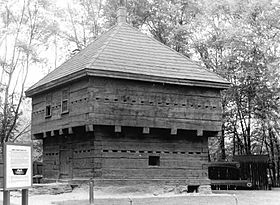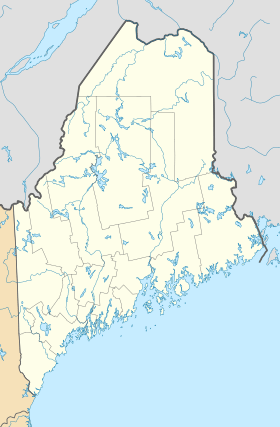Fort Kent (fort) facts for kids
|
Fort Kent
|
|
 |
|
| Nearest city | Fort Kent, Maine |
|---|---|
| Built | 1839 |
| NRHP reference No. | 69000005 |
Quick facts for kids Significant dates |
|
| Added to NRHP | December 1, 1969 |
| Designated NHL | November 7, 1973 |
Fort Kent is a historic fort located in Fort Kent, Maine. It sits right where the Fish River flows into the larger Saint John River. This fort is super important because it's the only American fort still standing from a time of border arguments with New Brunswick, Canada. This period was known as the Aroostook War.
Today, Fort Kent is a special place called the Fort Kent State Historic Site. You can visit its original log blockhouse during the summer months. The fort was added to the National Register of Historic Places in 1969. It was then named a National Historic Landmark in 1973, showing how important it is to our country's history.
Contents
What Does Fort Kent Look Like?
Fort Kent stands on a small hill. It gives a great view of the Saint John River. This river forms part of the Canada–United States border in this area. For many years, both the United States and the United Kingdom (which controlled New Brunswick) argued over who owned this land. This argument ended with the Webster-Ashburton Treaty in 1842.
The main part of Fort Kent that remains is a two-story blockhouse. It measures about 23 feet (7 meters) square. The blockhouse is made from strong, hand-cut cedar logs. Its second story hangs out over the first, and it has a pyramid-shaped roof. Each side of the roof has a small, gabled window.
Inside the Blockhouse
The main door faces west. On the first floor, there are four small openings for rifles next to the door. The other three sides of the first floor have twelve rifle openings each. The second floor, which sticks out about 15 inches (38 cm), has eleven rifle openings on the east and west sides. The north and south sides have fifteen rifle openings each.
There are also two larger openings for cannons on the first floor, on the north and south sides. Inside, some changes were made to add heating and plumbing. The blockhouse now also has museum displays for visitors to learn more about its history.
A Look Back: The Story of Fort Kent
The border between Maine and New Brunswick caused problems for a long time. This started after the Treaty of Paris in 1783, when Great Britain recognized the United States. Even after the Jay Treaty in 1797, the area around the upper Saint John River was still in dispute.
Both Maine and New Brunswick tried to develop the area. They wanted to show that the land belonged to them. This caused tensions to grow in the 1820s. Officials from each side sometimes acted against settlers or agents from the other side.
Building the Fort
Construction of Fort Kent began in 1838. This was when the border tensions were at their highest. The fort was named after Governor Edward Kent. It was one of several forts built by Maine along the Saint John River. Fort Kent is the only one of these original forts that still stands today. (The blockhouse at Fort Fairfield was rebuilt in the 1900s.)
In 1839, a US government agent was arrested in New Brunswick. This made the US Congress allow 50,000 federal troops to go to northern Maine. At this time, Fort Kent was made bigger. It added barracks for soldiers and officers' quarters. General Winfield Scott was sent to the area to help find a peaceful solution.
General Scott and New Brunswick's Lieutenant Governor John Harvey were good friends. They managed to calm things down. This helped lead to the Webster-Ashburton Treaty in 1842, which finally settled the border dispute.
After the War
United States troops stayed at Fort Kent until 1845. Once the border crisis was over, the fort was sold to private owners. In 1891, the state of Maine bought the property. They wanted to create a park there.
The state didn't do much work on the site until 1959. That's when the historic site was officially created. Today, the Fort Kent Historical Society helps maintain the museum.
See also


